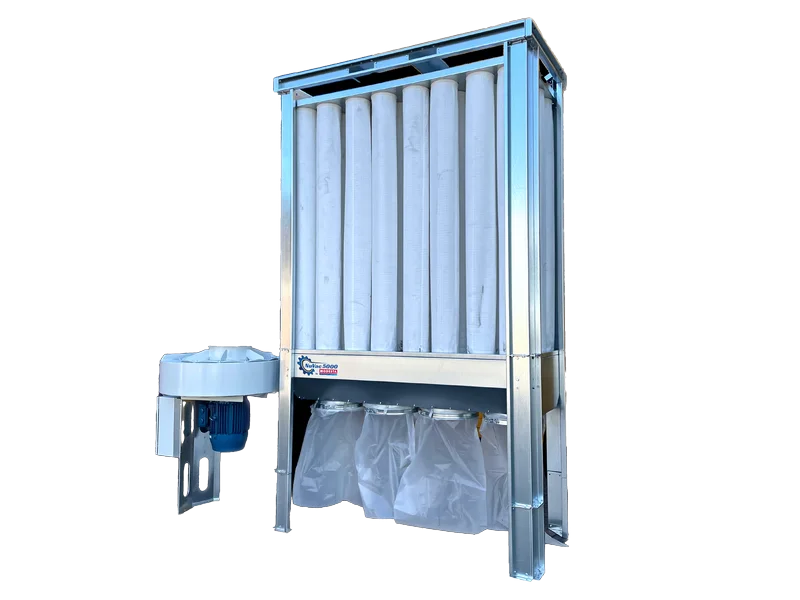Five Key Specifications Of An Indoor Dust Collector
A poorly performing dust collection system results in excessive dust that becomes a health hazard to employees and causes premature wear to the machinery you have invested in.
Purchasing the proper dust collector should not be overly complicated. There are five key technical specifications you should consider, ensuring the collector you invest in will properly perform. The goal of this article is to keep the information as simple as possible with basic definitions to simplify the process of choosing an indoor dust collector.
Knowing and having a basic understanding of the dust collector rating for the following five technical specifications will empower you to select the proper dust collector.
1. Cfm (cubic feet per minute)
2. Fpm (feet per minute) air speed the cfm is rated at
3. Wg (water gauge) measurement relating to performance when considering the resistance (static pressure loss) in the system
4. Filter Media Area (air to cloth ratio)
5. Hp (horsepower rating of the fan motor)
Dust Collector Cubic Feet Per Minute (CFM) Rating
The Cfm rating of a dust collector is the first specification buyers consider when purchasing a dust collector, but it certainly should not be the only specification considered. The Cfm rating of a dust collector is a calculation of the volume of air that passes through the system at a specified air speed. The volume of air is calculated by multiplying the square area of the dust collection pipe by the speed at which the air is traveling. For example, an eight inch pipe has an area of 0.349 feet. If we multiply that area by a desired air speed measured in feet per minute, we will determine the cfm in the pipe. To calculate the cfm in an eight inch pipe with a rated air speed of 4000 fpm and the same pipe with an air speed of 4500 fpm our formula would be
0.349x4000(fpm)=1396(cfm)
0.349x4500(fpm)=1570(cfm)
The same eight inch pipe can have different measurements of cfm due to different measurements of air speed inside the pipe. The cfm of a dust collector matters but it is also important to make certain that the speed of the air is fast enough to actually pick up the dust and chips at the dust guard.
Dust Collector Air Speed Measured in Feet Per Minute (FPM)
The speed of the air measured in feet per minute or fpm is as important as the cfm rating of a dust collector. There are several factors that determine a minimum air speed needed to properly collect dust and chips.
1. Material being cut is one factor that determines the speed of the air at the collection point. The heavier the dust and chips are the faster the air speed will need to be to collect them.
2. The type of blade, router bit, and rpm of the tooling determines the speed the dust and chips are propelled into the air. For example, high speed spindles will result in chips and dust moving at a much faster speed than material being cut on a slower moving band saw blade. The air speed at the point of collection will need to overcome the speed of the dust and chips if they are to be collected.
The minimum air speed in a branch pipe for wood dust should be 4000 fpm. Of course, if that air speed is increased you will collect a higher percentage of debris but there is a point of diminished return if your goal is to move the air as fast as you can. Dust is abrasive and moving dust at to0 fast of a rate can result in wear in pipe and the filter media. You should also consider you can only have a maximum rating of 5000 cfm per indoor dust collector. Theoretically, if you were able to obtain an air speed of 14,000 fpm in an eight inch pipe the entire 5000 cfm of the dust collector would be used in that one pipe. You would need dust collectors for every eight inch drop. This would become very costly. The first woodworking facility I worked at had an outdoor collector with a forty eight inch main trunkline. The air in the main trunk line was moving too slow and we ended up filling half of that forty eight inch pipe with dust and chips. The result was hours of plant downtime while we cleaned the main trunkline. Based on what I have seen over the last thirty two years evaluating and repairing machinery in the woodworking industry a good range of air speed to strive for is between 4500-5000 fpm with 4000 fpm being a bare minimum. Indoor units that move the air at a faster fpm should utilize a diverter in order to avoid damage to the filter media.
Overcoming Static Pressure Loss
Static pressure loss in the simplest terms is resistance to air movement in the dust hoods, duct work, and filter media. Shorter duct runs, fewer elbows, and clean filter bags will reduce the resistance to air movement reducing the static pressure loss in your system.
A key specification to know when evaluating dust collectors is the measurement of the dust collector’s ability to overcome static pressure loss. This ability is measured by inches of water in a water gauge. The cfm rating of a dust collector is the first and unfortunately sometimes the only specification considered by purchasers. If this is the only specification you look at it is unfortunate for this reason. You may determine you need a 5000 cfm dust collector based on the size of your duct work and desired air speed but if the dust collector you are purchasing has a low Wg rating it may not be able to overcome the static pressure loss and move 5000 cfm of air through your system. This can be better understood by examining one manufacturers cfm rating at different Wg measurements. The dust collector in this example has a rating of 3600 cfm at 6 Wg. The same dust collector in a system with more static pressure and a rating of 7 Wg is only rated at 2350 cfm. That is a loss of 1250 cfm capacity! The poorly planned duct run with unnecessary turns and bends and dirty filter media can dramatically increase the static pressure loss in your system resulting in insufficient dust and chip removal. The higher the Wg rating at a given cfm the more capable your dust collector will be to overcome the resistance in your system and deliver the needed cfm at the proper fpm.
Filter Media
The cloth bags are sometimes referred to as filter media. They have a key role in your dust collector. The dust and debris being pulled through your ductwork is prevented from entering back into the air by the filters. These filters are part of the static pressure loss in your system, so it becomes important to keep them as clean and free of dust that cakes on the inside of the filters as possible. It is also important to have a high enough surface area of the filter media to avoid a large static pressure loss in your system. The air-to-cloth ratio is often mentioned when talking about the performance of a dust collector. The air (cfm) and cloth (square footage of the filters) need to be properly balanced to minimize the effects of the dust that cakes on the inside of the filters. The square footage of the filters is not the only consideration, just one of many. A dust collector with a high Wg rating will overcome the static pressure loss from the dirty filters but keep in mind there is a balance to be maintained to avoid damage to the filters. Dust collectors with higher Wg ratings should utilize a diverter within the system to prevent damage to bags.
Motor Horsepower
Dust collectors with a balanced air to cloth ratio will reduce static pressure loss in your dust collection system. A larger sized motor will overcome the static pressure loss within your dust collection system. A larger motor will overcome the resistance within your system without bogging down and causing a loss in fpm, cfm, and a higher amperage draw that can be damaging to the motor.
There are a number of dust collectors with 10 hp motors that specify a 5000 cfm rating, but this rating is at a low Wg rating that is quickly exceeded by the duct work and dirty filter media. Exceeding the rated Wg by only 1 inch in the water gauge can result in a loss of up to 1250 cfm as noted in one manufacturers specifications in the static pressure loss section of this blog. The dust collectors better equipped to deliver the highest allowable cfm of 5000 for an indoor dust collector will utilize a 15 hp motor or larger with a higher Wg rating to overcome the static pressure loss.
Summary
When purchasing an indoor dust collector look for a collector with the proper cfm rating for a minimum air speed of 4000 fpm in the branches of your system. An air speed of 4500-5000 fpm is even better. Compare the Wg ratings to ensure your new dust collector will be able to overcome the static pressure loss in your system. Make certain there is adequate filter media surface area that will not quickly cake with dust and create a high static pressure loss reducing the collector’s ability to move air at the proper speed. A dust collector with a bag shaker or air blow down is a valuable feature to maintain your dust collection system. Make certain the fan motor is large enough to overcome the static pressure loss in the system.
To achieve a performance of 5000 cfm I invite you to consider the NuVac 5000 dust collector. The 5000 cfm rating at 11 Wg at over 4500 fpm will deliver the performance you need and the 430.6 ft2 surface area of the filter media with bag automatic bag shaker to clean them will reduce the static pressure loss within your system. Call Nutek Machinery at (216) 904-0215 by email at info@nutekmachinery.com to learn more and to order your NuVac 5000.



